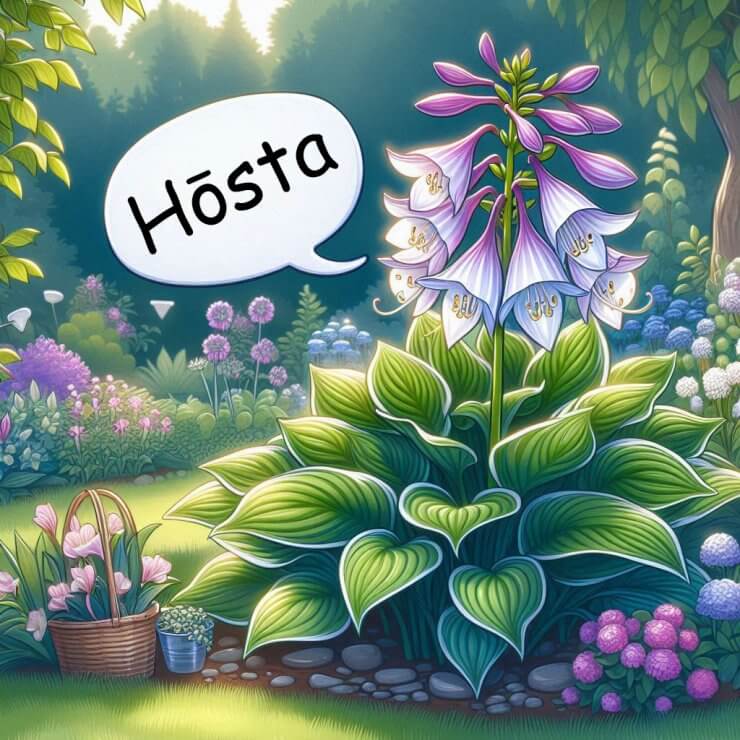Read by Natalie Carmolli*

The nurserywoman approached me and asked, “May I help you?” I replied, “Yes. Can you direct me to your hostas?”
“Our hostas are over here,” she said, leading the way.
“Why,” I asked, “do most people pronounce the plant name ‘hosta’? It was named in honor of an Austrian botanist, Nicolas Thomas Host—long o.”
“Oh, I didn’t know that,” she responded. Another saleswoman, walking by, overheard us and chimed in, “I didn’t either. But that makes sense. From now on I’m saying ‘hosta’—long o.”
“After all,” I returned, “at Christmastime, if you’re a believer, you wouldn’t say, ‘And suddenly there was with the angel a multitude of the heavenly hosst’!” We all laughed. And I bought my Hōsta ‘Patriot’.
Indeed, I try to remain patriotic to the correct pronunciation of botanical nomenclature, especially if it’s based on a person’s name. Granted, it’s not easy. One has to attend not only to the first name, which is always in Latin and capitalized but also to the second and even a third name, which may be a form of any language. The surname in Hosta sieboldiana, for instance, refers to botanist Siebold; if you realize that name is German, then you know it’s pronounced ‘See-bold,’ not ‘Sigh-bold.’
To pick up mispronunciations is not difficult if we hear a word or name repeatedly spoken incorrectly. But I do believe we should honor the name of those so honored whose names have been given to plants. Perhaps it’s because I spoke German before English that I have invariably spoken of the dahlia as ‘dall-ya’, which honors the name of Dr. Dahl. Still, to be consistent, we should say ‘kamelia’ (kam-ELL-ya) for camellia, named for Father Kamel, not ‘cameelia’, but I have never heard it uttered ‘kamelia,’ not even by me. The same is true for Deutzia, named for Johan van der Deutz: most of us say ‘dootsia’ when it should be ‘doytsia.’ I try.
Those lovely Winter flowers that look like the Shooting Star wildflower but with marbled, heart-shaped leaves are cyclamen, that is, ‘SIK-lamen,’ not ‘SIGH-klamen.’ The name derives from the Greek kykleminos. That first syllable is a kick, not a sigh. Then there is Co-TŌN-e-aster (long o), often misspoken ‘cotton-easter.’ Now, I know that cottontails are familiar during Easter, but this plant has no relation to that holiday nor to little bunnies.
Sometimes a mispronunciation occurs because of a misplaced accented syllable. That rampant plant Oxalis, which is the bane of my Spring garden and of our whole town, I’ve always heard called ‘ox-alice.’ Yet the correct pronunciation is ‘OX-a-lis.’ Nearly every word in Webster’s 3,210-page unabridged dictionary that begins with ox has the accent on the first syllable. Think: prickly ox-tongue, ox-eyed daisy, oxbane, oxberry, oxblood, oxbow, oxidation, Oxford, etc. However, since I’ve been mis-saying it for so long, can I teach this old dog a new trick (of the tongue)?
On the other hand, some botanical terms have two acceptable ways to utter them. Pittosporum, for example, can be pronounced ‘PITT-o-sporum’ or ‘pit-TOS-porum (a half-rhyme with petroleum). Ah, a choice! Sometimes we needn’t worry.
One pronunciation I find particularly distracting is the incorrect way to say clematis. The name comes from the Greek klema, meaning a “vine-branch.” Clematis does not rhyme with “running at us” or ‘window lattice.” It should be said CLEM-a-tis. Incidentally, this plant was first named and described in The Names of Herbes by William Turner in 1548.
Of course, there are such tongue-twisting plant designations as Matteuccia struthiopteris (the ostrich fern) or Polystichum acrostichoïdes (a sword fern), large enough mouthfuls to test the articulation of anyone but the most seasoned botanist. So perhaps we should be easy on ourselves and forgiving when using such less familiar terms.
But of the familiar, we can surely be more attentive, careful, and correct. Most of all, I do believe we should give honor to whom honor is due. Those intrepid plant hunters and botanists who braved seas and mountain ranges and jungles and deserts and hostile peoples, and who discovered and described new plants, deserve to be remembered respectfully for what they gave to the horticultural world. ❖
*Voiceover by Natalie Carmolli with Proven Winners® ColorChoice® Shrubs.
About the Author: Darrell G.H. Schramm is a Master Gardener, editor of two small rose publications, and the chair of the Heritage Rose Preservation Committee for the American Rose Society. His book Rainbow: A History of the Rose in California was published in 2017. His articles have appeared in horticultural and educational publications, such as Pacific Horticulture, American Rose, Historic Rose Journal (London), Families in Later Life, Journal X, and several dozen others.


 Previous
Previous

